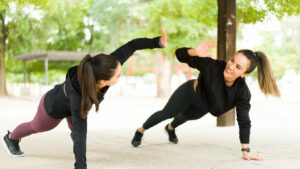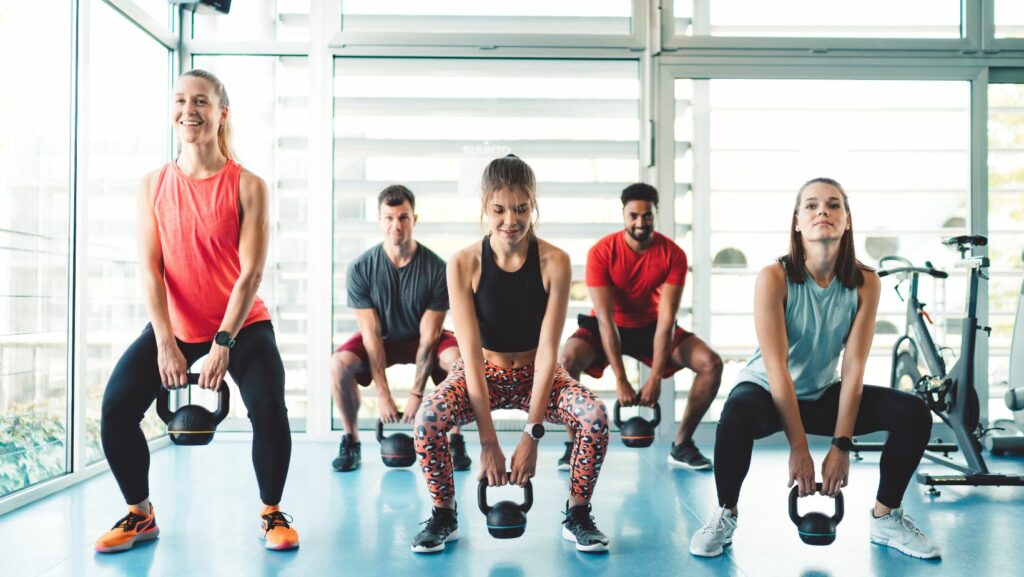Fitness Activities
- Diverse Options: Fitness activities encompass a variety of categories including aerobic, strength training, flexibility, and balance exercises, catering to different interests and fitness levels.
- Physical Benefits: Regular engagement in fitness activities boosts cardiovascular health, strengthens muscles, improves flexibility, and reduces injury risks.
- Mental Well-Being: Exercise not only enhances physical health but also boosts mood, reduces anxiety, and promotes better sleep through endorphin release and social connections.

- Community Engagement: Joining group classes and sports teams fosters social interaction, creating supportive communities that motivate continued participation.
- Personalization is Key: Choosing fitness activities should align with individual goals, physical limitations, and personal preferences to ensure long-term adherence and satisfaction.
- Holistic Health Approach: Embracing a variety of fitness activities contributes to a balanced lifestyle, enhancing both mind and body for overall well-being.
In today’s fast-paced world, staying active is more important than ever. Fitness activities not only boost physical health but also enhance mental well-being, making them essential for a balanced lifestyle. From high-energy workouts to calming yoga sessions, there’s something for everyone looking to get fit and feel great.
Exploring various fitness activities can lead to discovering new passions and building a supportive community. Whether it’s hitting the gym, joining a dance class, or enjoying outdoor adventures, these activities offer countless benefits. Embracing a diverse fitness routine can transform not just the body, but also the mind and spirit, paving the way for a healthier, happier life.
Table of Contents
ToggleOverview of Fitness Activities
Fitness activities encompass a wide range of options designed to enhance physical health and mental well-being. These activities vary in intensity and style, catering to diverse interests and fitness levels.
Categories of Fitness Activities
- Aerobic Activities: Aerobic exercises increase heart rate and improve cardiovascular health. Examples include running, cycling, and swimming.
- Strength Training: Strength-building activities promote muscle growth and endurance. Common examples are weightlifting and resistance band workouts.
- Flexibility Exercises: Flexibility-focused activities enhance range of motion and reduce injury risks. Yoga and Pilates serve as popular examples.
- Balance Training: Balance activities improve stability and coordination. Tai Chi and specific stability ball workouts exemplify this category.
Popular Fitness Activities
- Group Fitness Classes: Group classes offer motivation and community. Zumba, spinning, and boot camp classes are among the favorites.
- Outdoor Activities: Outdoor exercises connect individuals with nature. Hiking, kayaking, and rock climbing provide both fitness and adventure.
- Individual Sports: Individual sports allow focused competition. Tennis, martial arts, and cycling attract participants looking for personal achievement.
- Physical Health: Regular participation in fitness activities enhances overall health. It reduces the risk of chronic diseases, strengthens bones, and improves muscle strength.
- Mental Health: Engaging in fitness activities boosts mood and reduces anxiety. Exercise releases endorphins, promoting a sense of well-being.
- Social Connections: Many fitness activities foster connections. Joining group classes or sports teams creates opportunities for social interaction and support.
Embracing a variety of fitness activities can help individuals maintain an active lifestyle while enjoying the benefits that come with regular movement.
Types of Fitness Activities
Fitness activities encompass various methods that promote physical health and overall well-being. Below are key categories of fitness activities that individuals can engage in.
Aerobic Exercises
Aerobic exercises elevate heart rates and enhance cardiovascular endurance. Examples include running, cycling, swimming, and dancing. These activities improve lung capacity and increase stamina while aiding in weight management. Engaging in at least 150 minutes of moderate aerobic activity weekly contributes to substantial health benefits. To ensure a safe and comfortable workout environment, consider investing in durable fitness flooring for your exercise space.
Strength Training
Strength training focuses on building muscle and improving strength. Activities such as weightlifting, resistance band exercises, and bodyweight workouts fall under this category. Regular strength training enhances metabolism, supports joint health, and increases muscle mass. Performing strength training exercises at least twice a week helps maintain muscle function with age.
Flexibility and Stretching
Flexibility and stretching exercises improve the range of motion and reduce the risk of injury. Yoga and Pilates are common examples that promote flexibility while also enhancing body awareness. Incorporating flexibility exercises into a fitness routine increases overall mobility and aids in muscle recovery. Frequent stretching sessions can lead to improved posture and reduced muscle tension.
Balance and Coordination
Balance and coordination exercises enhance stability and prevent falls, particularly in older adults. Tai Chi, yoga, and specific balance drills are effective in developing these skills. Practicing balance exercises regularly increases body awareness and enhances overall athletic performance. Implementing balance training at least two to three times weekly improves coordination and reduces the risk of injury.
Benefits of Fitness Activities
Regular participation in fitness activities brings numerous benefits, significantly impacting both physical and mental health. Engaging in various forms of exercise contributes to a healthier lifestyle and a greater sense of well-being.
Physical Health Benefits
Fitness activities provide extensive physical health benefits. Engaging in aerobic exercises like running or cycling boosts cardiovascular endurance, reducing the risk of heart disease. Strength training enhances muscle mass and overall strength, promoting metabolic health. Flexibility exercises such as yoga improve range of motion, leading to better mobility and a lower risk of injuries. Balance training, exemplified by Tai Chi, decreases fall risk, particularly among older adults. Furthermore, consistent exercise contributes to weight management, strengthens bones, and augments overall physical stamina.
Mental Health Benefits
Fitness activities also offer substantial mental health benefits. Regular exercise enhances mood by releasing endorphins, which can alleviate feelings of depression and anxiety. Participation in group fitness classes fosters social connections, creating a supportive community that uplifts and motivates individuals. Exercise can improve cognitive function and memory, contributing to better focus and productivity. Additionally, engaging in physical activities promotes better sleep quality, reducing insomnia and enhancing overall mental well-being.
How to Choose the Right Fitness Activity
Choosing the right fitness activity involves understanding personal goals, recognizing physical limitations, and exploring enjoyable options. These factors help individuals select activities that enhance their fitness journey.
Assessing Personal Goals
Identifying fitness goals lays the foundation for choosing appropriate activities. Goals may vary, including weight loss, muscle gain, improved endurance, or stress relief. Setting specific objectives, such as losing 10 pounds in three months or running a 5K, provides clarity. Evaluating these goals regularly can also facilitate adjustments and measure progress. By aligning fitness activities with personal aspirations, individuals maintain motivation and commitment.
Considering Physical Limitations
Recognizing physical limitations is essential for selecting safe and effective fitness activities. Common limitations might include previous injuries, chronic conditions, or mobility issues. Consulting healthcare professionals or certified trainers ensures chosen activities accommodate these limitations and promote overall well-being. For instance, individuals with joint pain may benefit from low-impact exercises like swimming or cycling. Prioritizing safety enhances the likelihood of enjoying and sticking with fitness routines.
Finding Enjoyable Activities
 Finding enjoyable fitness activities contributes to long-term adherence and satisfaction. Exploration includes trying different classes, outdoor sports, or solo workouts. Participating in group classes often fosters a sense of community, providing motivation and accountability. Alternatively, individuals might discover joy in solo activities, such as hiking or dancing. Assessing preferences helps create a sustainable fitness routine, enhancing both enjoyment and commitment to an active lifestyle.
Finding enjoyable fitness activities contributes to long-term adherence and satisfaction. Exploration includes trying different classes, outdoor sports, or solo workouts. Participating in group classes often fosters a sense of community, providing motivation and accountability. Alternatively, individuals might discover joy in solo activities, such as hiking or dancing. Assessing preferences helps create a sustainable fitness routine, enhancing both enjoyment and commitment to an active lifestyle.
Balanced and Fulfilling Life
Embracing fitness activities is a key step toward achieving a balanced and fulfilling life. By exploring various options individuals can find what resonates with them and enhances their overall well-being. Whether it’s the thrill of a high-energy workout or the tranquility of yoga each activity offers unique benefits that cater to different preferences and goals.
Regular participation not only strengthens the body but also uplifts the mind creating a holistic approach to health. The journey toward fitness is personal and discovering enjoyable activities can lead to lasting commitment and a vibrant community. With consistency and passion anyone can cultivate a healthier lifestyle that promotes both physical and mental vitality.



